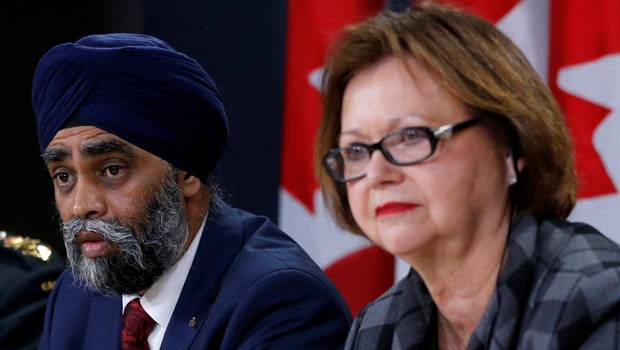
“Oh! What a tangled web we weave…”
Sir Walter Scott, Marmion (1808)
The government’s tortured path towards an eventual replacement fighter aircraft took yet another bizarre twist on May 18th with the Global Affairs Minister’s announcement that “Canada is reviewing current military procurement that relates to Boeing.” However, this is only the latest in a string of apparently disconnected and sometimes self-contradictory steps that inevitably lead observers to question whether there is any coherent strategy guiding the government’s management of this important file.
Let’s briefly review the evidence:
Exhibit A
During the 2015 election the Liberal Party platform, among other things, promised to exit the F-35 program and instead “…purchase one of the many, lower-priced options that better match Canada’s defence needs.” The funds saved would be redirected to the naval shipbuilding program.
This may seem at first glance like a simple and reasonable rebalancing of defence requirements, but two major problems quickly emerge upon closer scrutiny. First, effective surveillance and protection of our maritime and air approaches are equally imperative “no-fail” tasks for Canada, both in terms of our own defence and our obligations to our US partner in the defence of North America. One capability can’t be privileged over the other without significant risk to our national security, sovereignty, and public confidence in the national government.
Second, even a cursory read of the many fighter costing studies and reports prepared by multiple independent authorities over the past five years will show that it is highly doubtful that substantial savings are to be found from buying any of the “lower-priced” alternatives. An advanced fighter capability costs somewhere north of $1B a year to acquire and maintain no matter which aircraft you buy.
Consequently, it is hard to see much serious deliberation having gone into this commitment.
Exhibit B
Upon taking office, the new government was forced to walk back from its promise to exclude the F-35 from its planned “open and transparent competition.” Quite apart from the fact that the promise was self-contradictory (which should have raised flags when it was being framed) the arbitrary exclusion of any single candidate would very likely be illegal.
At the same time, the government came face-to-face with the reality that the Canadian aerospace industry is heavily committed to the F-35 program, largely due to the privileged access partner nations have to related contracts. This access derives from a Canadian government commitment to the US-led multinational Joint Strike Fighter Program dating from 1997, and renewed by successive governments. Withdrawing from it would have a massive impact on Canada’s aerospace sector both in terms of business volumes and access to important new exploitable technologies, a fact that cannot have come as a surprise to anyone as the arrangement was public knowledge and had been a major area of focus for a 2012 Auditor General report.
The upshot of all this is that the election commitment to “not buy the F-35” morphed into a post-election commitment to “not necessarily buy the F-35” and the government continues spending many tens of millions of Canadian taxpayers’ dollars on the ongoing development of the aircraft in order to maintain access to the economic and technology benefits the program is delivering.
Exhibit C
Faced with the potential for its “open and transparent” competition to be won by the F-35 (it won Denmark’s competitive selection process last year hands-down) the government next decided to push the fighter replacement decision down the road as much as five years, i.e. until after the next election. It then subsequently opened the door to an earlier process.
Concurrently with the initial decision, and for reasons that it has still not explained, the government also chose to make a major defence policy change and require the RCAF to meet Canada’s NATO and NORAD fighter commitments simultaneously. Successive governments since the withdrawal of the Canadian Armed Forces from their Cold War bases in Europe have directed only that the RCAF risk-manage the commitments – in other words balance the forces assigned to each based on the available assets. This approach was more recently supported by a Defence Research and Development Canada analysis which concluded that the current fighter fleet would remain capable of meeting its present commitments long enough for an orderly replacement program to be undertaken, provided it was not unduly delayed.
The policy change did two things. It created a capability gap where none previously existed, which the government planned to fill with an interim purchase of 18 Boeing Super Hornet aircraft. But more importantly, it effectively committed the government to acquiring and sustaining a significantly larger fighter fleet.
The practical impact of this decision was to render the original intent to save money on the fighter program impossible to meet. Instead, the fighter capability will need significant additional funding to meet the revised policy requirement.
Exhibit D
Enter Boeing and its trade complaint against Bombardier. The company will not likely have been greatly surprised by the resulting Canadian government threat to terminate discussions about the potential buy of 18 Super Hornets. They clearly see the potential loss of this sale (representing less than 3% of total production for the type) as a much lesser risk than the long-term threat it sees in Bombardier’s C-Series Program.
This part of the drama will take some time to play out, but Boeing may have thrown the government a lifeline to potentially escape from what has clearly become a politically convoluted fighter replacement file. Whether it will take advantage of it remains to be seen.
How Does it All Add Up?
It is difficult, if not impossible, to see any strategic coherence in the handling of this file at any point up until now – or to see the process as anything but a series of lurches from decision to decision with little thought about what comes next and what the end state is intended to be. How else can we explain how a political promise to save substantial funds from the fighter program mutated into a policy imperative to spend substantially more on a larger fighter capability?
Fortunately, the government has an opportunity to reset the narrative and finally articulate a rational approach to fighter replacement in the context of the forthcoming release of its defence policy. It is to be hoped that it does so because the Canadian Armed Forces and the Canadian public need their governments to make and communicate rational decisions based on objective and sound analysis. It is also in the government’s own self-interest to do so, having campaigned on a core promise to bring back transparent, evidence-based decision-making. To get out of the tangled web that has been created around the CF-18 replacement it will need to begin walking that talk – and soon.
 Charles Davies is a retired CAF officer and a Fellow of the CDA Institute. He has written extensively on defence procurement, defence policy, defence management, and other related issues.
Charles Davies is a retired CAF officer and a Fellow of the CDA Institute. He has written extensively on defence procurement, defence policy, defence management, and other related issues.